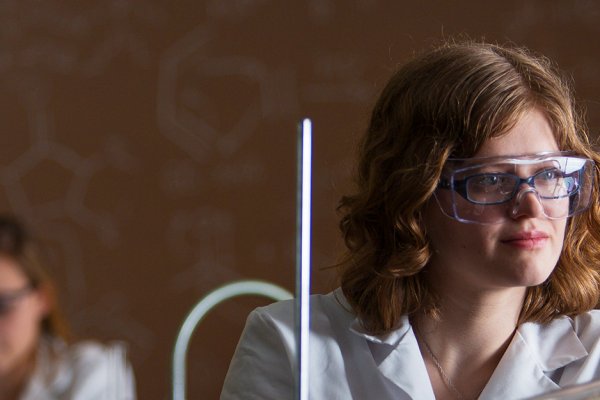Facilities
Valpo’s resources give students outstanding hands-on opportunities.
Collaborative Atmosphere
Chemistry courses at Valpo take place in the new Center for the Sciences as well as the Neils Science Center, which houses three natural science departments: biology, chemistry, and physics and astronomy. The Center for the Sciences includes:
- Teaching labs for general chemistry, organic chemistry, analytical chemistry, physical chemistry, and biochemistry
- Multiple chemistry research labs for faculty and collaborative research
- An instrument room housing the department’s cutting-edge equipment
Sophisticated Instrumentation
Chemistry students have access to a wide variety of modern instrumentation, for laboratory classes as well as student research. The collection includes a research-grade nuclear magnetic resonance spectrometer and other specialized instruments.
Spectrometers are generally used to identify atoms, molecules, or crystals and study their behavior under different conditions. Valpo’s resources include:

- Fourier transform nuclear magnetic resonance spectrometer (FT-NMR) – Bruker Avance III 400 MHz – Used to determine the structure of various compounds
![]()

- Fourier transfer infrared spectrometer (FTIR) – Thermo-Nicolet NEXUS 670 FT-IR – Used to determine and identify molecular structure by using a substance’s vibrational properties
![]()

- Ultraviolet/visible spectrometers (UV/VIS) – Perkin Elmer Lambda 650, Beckman, and HP diode array – Used to make qualitative and quantitative analysis using a sample’s ability to absorb visible and ultraviolet light
![]()

- Fluorescence spectrometer – ISS PC1 Spectrometer – Used to probe protein-substrate interactions and molecular organization
![]()

- Atomic absorption spectrometer (AA) – GBC 933AA – Used to analyze trace metals in solution
![]()

- X-ray diffractometer – Rigaku Miniflex 600 – Used to determine powder patterns of crystalline materials
Chromatography systems are generally used to separate a mixture of molecules into individual components. Valpo’s resources include:

- Gas chromatograph-mass spectrometer (GC-MS) – Agilent 7890A/5975C – Used to separate and identify compounds in mixtures
![]()

- Gas chromatograph (GC) – HP5890 and HP6850 – Used to separate volatile mixtures
![]()

- High-performance liquid chromatograph (HPLC) – Beckman Coulter System GOLD – Used to separate non-volatile mixtures and aqueous solutes. Dual solvent system for complex mixtures.
![]()

- High-performance liquid chromatograph (HPLC) – Agilent 1100 – Autosampler with MWD and VWD detectors. Flow rates with capillary and binary pump vary from 20-10,000 uL/min.
![]()

- High-performance liquid chromatograph (HPLC-MS) – Waters ACQUITY – Used to separate non-volatile mixtures and aqueous solutes. Ultra high pressure throughput system with autosampler. Equipped with photodiode array and electrospray ionization mass spectrometer.
![]()

- Electrospray ionization mass spectrometer (ESI-MSn) – Agilent 1100 Trap – Ion trap mass spectrometer equipped with ESI, APCI, Nano ESI and MALDI sources. CID capable mass range from 40-4000 m/z.
![]()

- Capillary electrophoresis (CE) – Agilent CE 7500 – Capillary electrophoresis instrument with microcapillary capability and mass spectrometer coupling
![]()

- Gel electrophoresis – X-Sure Lock – Used to separate protein mixtures
Specialized biochemistry instruments are generally used in research and classwork on biologically relevant systems that require specialized equipment and instrumentation to work with cells and cultures. Valpo’s resources include:

- Real-time polymerase chain reaction instrument – BioRad – Used to amplify DNA or RNA samples
![]()

- Microtiter Plate Reader – BMG LabTech CLARIOStar – Used to measure absorbance, fluorescence, fluorescence polarization and bioluminescence in small sample volumes
![]()
- Protein Purification system – ATKA GE FPLC – Used to isolate and quantify proteins
- Superspeed Centrifuge – Beckman – Used to separate components by spinning them at high speeds to concentrate materials of interest
- High-capacity refrigerated centrifuge – Juan – Used to separate large quantities of solutions by spinning them at high speeds to concentrate materials of interest at lower temperatures
Other specialty equipment is used in a variety of fields, generally for particular analysis that requires unique setups. Valpo’s resources include:
- Microbalance – Cahn – Used to weigh minute quantities of protein
- Magnetic Susceptibility – Johnson Matthey – Used to determine number of unpaired electrons in metallic compounds
- Electrochemical Workstation – BAS – Used to examine the electrochemical properties of materials
- Polarograph/Voltammeter – Princeton Applied Research – Used to examine the electrochemical properties of materials
![]()

- Vibrating Orifice Aerosol Generator (VOAG) – TSI – Aerosol generator capable of generating 1-200 um particles in both hydrated and anhydrous compositions
![]()

- Ultrapure Glovebox Modular Hood (UGMH) – MBraun – Nitrogen-fed glove box for air sensitive synthesis of organic and inorganic constituents
![]()

- High-volume solvent delivery system (HVSDS) – MBraun – Nitrogen solvent delivery module for synthesis of organic and inorganic constituents
![]()

- Computational chemistry workstation – Dell – WebMO-enabled eight-node server with Gaussian09, MOPAC, NWChem 5 and GAMESS
